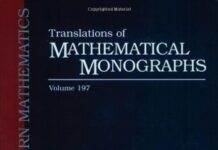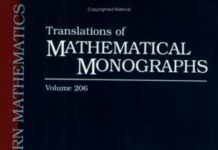
Ebook Info
- Published: 1999
- Number of pages: 168 pages
- Format: PDF
- File Size: 4.56 MB
- Authors: Kenji Ueno
Description
This is the first of three volumes on algebraic geometry. The second volume, Algebraic Geometry 2: Sheaves and Cohomology, is available from the AMS as Volume 197 in the Translations of Mathematical Monographs series.
Early in the 20th century, algebraic geometry underwent a significant overhaul, as mathematicians, notably Zariski, introduced a much stronger emphasis on algebra and rigor into the subject. This was followed by another fundamental change in the 1960s with Grothendieck’s introduction of schemes. Today, most algebraic geometers are well-versed in the language of schemes, but many newcomers are still initially hesitant about them. Ueno’s book provides an inviting introduction to the theory, which should overcome any such impediment to learning this rich subject.
The book begins with a description of the standard theory of algebraic varieties. Then, sheaves are introduced and studied, using as few prerequisites as possible. Once sheaf theory has been well understood, the next step is to see that an affine scheme can be defined in terms of a sheaf over the prime spectrum of a ring. By studying algebraic varieties over a field, Ueno demonstrates how the notion of schemes is necessary in algebraic geometry.
This first volume gives a definition of schemes and describes some of their elementary properties. It is then possible, with only a little additional work, to discover their usefulness. Further properties of schemes will be discussed in the second volume.
User’s Reviews
Editorial Reviews: Review “This treatise may serve as a first introduction for any student interested in algebraic geometry in the style of Grothendieck. It provides basic concepts and definitions, even introducing such notions as localizations, tensor products and inductive and projective limits. The material is illustrated by examples and figures, and some exercises provide the option to verify one’s progress.” —- Mathematical Reviews”This masterly written text, now also available to the international mathematical audience, tells its own tale and represents a highly welcome addition to the great standard textbooks on algebraic geometry.” —- Zentralblatt MATH From the Publisher This masterly written text, now also available to the international mathematical audience, tells its own tale and represents a highly welcome addition to the great standard textbooks on algebraic geometry. Zentralblatt f”ur Mathematik”
Reviews from Amazon users which were colected at the time this book was published on the website:
⭐This is the first volume of a three set volume set of books intended to introduce you to Grothendieck’s view of what algebraic geometry should be. Following Hartshorne’s presentation of Grothendieck’s ideas, it starts with a brief review of some basic results of classical algebraic geometry, which deals with the set of zeros of polynomials over an algebraically closed set. All of this is used to show the reader some of the limitations of the methods of classical algebraic geometry, leaving the door open to the necessity of a more abstract and general idea of algebraic (or projective) variety. This is the beginning of scheme theory, which starts in chapter 2 of this first volume. There is a clear intention of the author to put emphasis on the understanding of the subject rather than reaching sophisticated technical levels in the results. This effort is reflected in the presentation of many worked out examples, explanation of basic results of commutative algebra needed in the text and exercises with solutions or hints at the end of the book. There is another book by Ueno dealing with elementary algebraic geometry, with the same pedagogical style showed in the present book.
⭐Algebraic geometry in modern times is not an easy subject. A better introductory text is
⭐.My beef with this type of Mathematical writing is old: the writer gives the student nothing but a new axiomatic language without “context” or contact with objective reality ( no real pictures of the geometry involved).He also expects after we have read this badly written text to buy volumes 2 and 3? He is not alone in going over students heads in Algebraic Geometry.I bought this hoping that it would give a decent introduction to Schemes.It doesn’t even give an a good introduction to Zariski topology or whyZariski (T0) instead of Hausdorff (T2) … ? The examples, problems and definitions are pretty bad too. If you want your grad students in massive depression while taking your course, use this as a text? I bought this book after doing several weeks of searching for a cheap bookthat covered the areas I wanted to learn.I’ve pretty much come to the conclusion there are some very strange people in this field and very few real teachers?If in you are presenting a subject in Mathematics in an Axiomatic form like this, you have to tell the people why the axioms/ theorems are as they are: not just give definition in strange symbols and prove using the same new notation.I’ve seen worse than this text, but not by much?
⭐for example.Presenting Zariski tangent space without a diffeomorphism definitionis just really bad Mathematics with no excuse in my mind?Presenting Schemes without reference to Galois theory is not a very good idea either? Not mentioning that Algebraic geometry uses Zariski topology because it excludes the transcendental numbers ( no algebraic variety has root that is Pi or e). Some bridge to measure theory for Schemesseems necessary, since the use of “spectrum” in the definition tends to confuse the student for other areas that are more concretely defined?The father of algebraic geometry is Descartes,yet he seems to never be mentioned. Instead Grothendieck appears everywhere where things get most dense? I repeat, if you are approaching a subject axiomatically, you have to made plain the basis for those axioms. And algebra without algebra ( polynomials) and geometry without geometry ( pictures) is probably very confusing to most students.
⭐This text takes the time to explain concepts at the level of a non expert. I like the fact it isn’t encyclopedic and covers just enough commutative algebra to understand, varieties, the prime spectrum and schemes. I highly recommend it before reading one of the longer, classics.
⭐A nice book with details worked out but quite a few typos.
Keywords
Free Download Algebraic Geometry 1: From Algebraic Varieties to Schemes (Translations of Mathematical Monographs) (Vol 1) (Iwanami Series in Modern Mathematics) in PDF format
Algebraic Geometry 1: From Algebraic Varieties to Schemes (Translations of Mathematical Monographs) (Vol 1) (Iwanami Series in Modern Mathematics) PDF Free Download
Download Algebraic Geometry 1: From Algebraic Varieties to Schemes (Translations of Mathematical Monographs) (Vol 1) (Iwanami Series in Modern Mathematics) 1999 PDF Free
Algebraic Geometry 1: From Algebraic Varieties to Schemes (Translations of Mathematical Monographs) (Vol 1) (Iwanami Series in Modern Mathematics) 1999 PDF Free Download
Download Algebraic Geometry 1: From Algebraic Varieties to Schemes (Translations of Mathematical Monographs) (Vol 1) (Iwanami Series in Modern Mathematics) PDF
Free Download Ebook Algebraic Geometry 1: From Algebraic Varieties to Schemes (Translations of Mathematical Monographs) (Vol 1) (Iwanami Series in Modern Mathematics)





